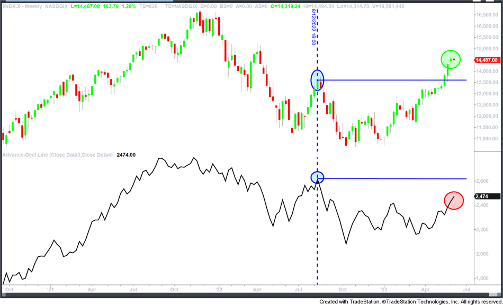Earlier this week, some of the biggest tech stocks in the market lost tens of billions in collective value in a single day.
Nvidia and Meta … both down 3%. Google … down 3.9%. Amazon … down 4.3%.
Those sharp single-day losses surprised folks … mainly because the Nasdaq 100 has been cranking higher in 2023.
It’s up 34% this year. That trounces the returns of the Dow Jones Industrial Average (+2.3%), Russell 2000 (+7.6%) and S&P 500 (+12.7%).
Of course, this hasn’t come from nowhere. A lot of this has to do with the dominant investment narrative this year: artificial intelligence (AI).
ChatGPT has stoked a groundswell of interest and optimism. Beyond the use cases of today, pundits are leaping to far-out speculations about what AI might accomplish down the road.
At this point in the hype cycle, it seems like everything even tangentially AI-related is catching a monster bid. That’s naturally going to benefit the tech-heavy Nasdaq 100.
But, against the backdrop of one of the fastest tech rallies in history, we must ask an important question:
Has the current hype cycle in AI gotten “over its skis” … and will an eventual cooling-off take the Nasdaq’s 2023 gains down with it?
To answer that question, let’s look under the hood of the Nasdaq and see how deep this rally runs…
The “Shallow Rally”
I won’t mince words … the Nasdaq’s 2023 rally is shallow. And we can be confident of that because of breadth analysis.
Breadth, simply put, refers to how many stocks in an index are participating in the rally. Rallies built on weak breadth don’t tend to last … and can reverse on a dime.
So for us to be fully confident in this year’s Nasdaq 100 rally, we’d like to see most, if not all, of the stocks within it trading higher.
But so far in 2023, only six companies have accounted for more than 100% of the Nasdaq 100’s gains this year.
Have a look:
That’s not a good sign. Such concentrated gains make the Nasdaq 100 especially vulnerable to a broader tech slowdown and an easing of the AI hype.
Another simple way to measure breadth is the advance-decline (A/D) line. The line simply measures the net number of stocks trading higher over time. The higher the line, the more stocks within an index are moving higher.
Here’s a chart of the Nasdaq 100 Index (top) paired with its A/D line (bottom):
Let’s start our look with the last major top in the Nasdaq, on the week ending August 19, 2022.
We want to see a simple pattern across both the price level of the Nasdaq and the A/D line. If the index is making a new, higher high … we also want to see the A/D line making a new, higher high along with it. This would confirm that an increasing number of stocks are advancing higher, supportive of a “broad-based” rally.
That’s not what we’re getting here. We can see that even though the Nasdaq 100 has made a higher high since August, the number of stocks participating in that rally has not caught up. The rally is more concentrated … so we should exercise caution.
Another way to look at breadth involves how many individual stocks within an index are making new 52-week highs.
Based on its highest price of the week, the Nasdaq 100 has made a new 52-week high each of the last four weeks. But only 24 individual stocks (of the 100 stocks in the index) have made a new 52-week high at any point in the past four weeks.
Meaning, 75% of stocks in the index have not made new 52-week highs alongside the index. What’s more, only 12% of stocks in the index have made a new 52-week high this week.
This suggests fewer stocks are participating in the Nasdaq’s rally, and that it’s likely running out of steam.
Finally, we can look to history to see similar years where the Nasdaq had a strong start.
In the past, the Nasdaq ran more than 20% higher in the first 100 days of the year four times — in 1975, 1983, 1986 and 1991. Three out of those four times, the index ended the year lower than it was at day 100.
So, there’s a lot of reason to be suspicious about the 2023 Nasdaq rally. So if you’re an individual investor sitting on huge tech gains and not you’re keen to give them up, what should you do?
How to Hedge a Nasdaq Reversal
If you’re worried that hedging means short selling stocks or trading futures on margin, I’m pleased to inform you that’s not the case.
Instead, all you need to do is buy shares of an inverse Nasdaq exchange-traded fund (ETF). The share price of an inverse ETF is designed to go up while the price of the index is going down.
ProShares offers three such ETFs with varying degrees of aggressiveness:
- ProShares Short QQQ ETF (PSQ) (-1X) is designed to provide a 1-to-1 inverse return of the Nasdaq 100’s daily change.
- ProShares UltraShort QQQ ETF (QID) (-2X) is designed to provide twice the inverse of the index’s daily change.
- ProShares UltraPro Short QQQ ETF (SQQQ) (-3X) is designed to provide three times the inverse of the index’s daily change.
These inverse Nasdaq ETFs are well worth your time and consideration. They can be potent hedges when well-timed and used conservatively.
For instance, when shares of the Invesco QQQ Trust (QQQ) fell 25% from mid-August to mid-October last year, shares of SQQQ gained more than 100%. Even a small allocation would have done wonders to mitigate the drawdown in an equity-heavy portfolio — of Nasdaq stocks or otherwise!
Though, if you decide to add one of these hedges to your portfolio, I’d suggest establishing a stop-loss level as you enter the trade. These tickers make better short-term hedges than long-term ones and can make large overnight moves.
Of course, there’s plenty more you can do on the bullish side of things if that’s where you prefer to stay. Especially…
Buying “Diversified Moonshots”
I’ve spent the last year and a half putting together a high-octane portfolio of stocks that have all the moonshot potential of yesteryear’s tech darlings … without the same risks that are so concentrated in that sector.
With this portfolio, we don’t need NVDA to tack on a hundred billion dollars in market cap in a single day … or for Apple’s Vision Pro headset to become as big as the iPhone.
We buy small-cap, under-the-radar names with huge mega trends at their backs. Stocks that Wall Street clearly hasn’t discovered yet.
As just one example, we recently booked 100% gains on web browser company Opera (Nasdaq: OPRA) in just three months. That triples the return of the Nasdaq itself, and outperforms many other Nasdaq stocks, without the risk of buying the overvalued, mega-cap names that have dominated the recent rally.
We don’t just buy tech stocks, either. We have exposure to energy stocks … foreign markets … and other huge investment themes I’ve been watching closely this year.
Right now, I’m offering a discount on access to this service as part of a special piece of research I published on $5-and-under small-cap stocks. These names hold the unique position of being “off-limits” to major institutional investors, giving us a leg up on Wall Street’s biggest competition.
You can learn all about these stocks, and the SEC rule that puts investors like you and me in such a rare beneficial position, right here.
And stay tuned right here to The Banyan Edge this Sunday, where I’ll share part of the process I use to find these names.
To good profits,
 Adam O’DellEditor, 10X Stocks
Adam O’DellEditor, 10X Stocks






